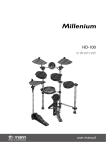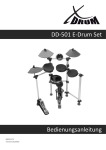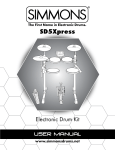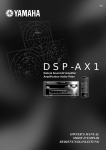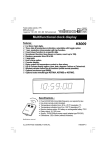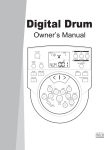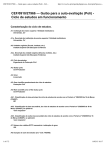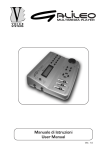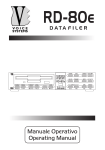Download Medeli DIGITAL DRUM Instruction manual
Transcript
DD-501 E-Drum Set Users manual 00022173 Version 01/2010 Congratulations! Thank you for purchasing this digital drum module. The drum module has been developed to act and play like a drum set but with greater ease. Before you use the instrument, we recommend you to read through this manual. Taking Care of Your Digital Drum Set Location Handling and Transport Do not expose the unit to the following conditions to avoid deformation, discoloration, or more serious damage. Direct sunlight. High temperature (near a heat source, or in a car during the day time). Excessive humidity. Excessive dust. Strong vibration Never apply excessive force to the controls, connectors or other parts of the instrument. Always unplug cables by gripping the plug firmly, but not pulling on the cable. Disconnect all cables before moving the instrument. Physical shocks caused by dropping, bumping, or placing heavy objects on the instrument can result in scratches and more serious damage. Power Supply Make sure to use the suitable AC adaptor, and also make sure the AC outlet voltage at your country matches the input voltage specified on the AC adaptor`s label. Turn the power switch OFF when the instrument is not in use. An AC adaptor should be unplugged from the AC outlet if the instrument is not be used for an extended period of time. Unplug the AC adaptor during electric storms. Avoid plugging the AC adaptor into the same AC outlet as appliance with high power consumption, such as electric heaters or ovens. Also avoid using multiplug adaptors since these can result in reducing the sound quality, operation errors, and possibly damage. Cleaning Clean the unit with a dry soft cloth. A slightly damp cloth may be used to remove stubborn grime and dirt. Never use cleaners such as alcohol or thinner. Avoid placing vinyl object on top of the unit (vinyl can stick to and discolor the surface). Electrical Interference This instrument contains digital circuitry and may cause interference if placed too close to radio or television receivers. If this occurs, move the instrument further away from the affected equipment. Radiated Immunity The normal function of the product may be disturbed by Strong Electro Magnetic Interference. If so, simply reset the product to resume normal operation by following the instruction manual. In case the function could not resume, please use the product in other location. ESD, Fast Transient and Surge may cause the unit to temporary malfunction. Switch off and on again to resume normal operation. Turn Power OFF When Making Connections To avoid damage to the instrument and other devices to which it is connected, turn the power switches of all related device OFF prior to connecting or disconnecting cables. THIS DEVICE COMPLIES WITH PART 15 OF THE FCC RULES. OPERATION IS SUBJECT TO THE FOLLOWING TWO CONDITIONS: (1) THIS DEVICE MAY NOT CAUSE HARMFUL INTERFERENCE, AND (2) THIS DEVICE MUST ACCEPT ANY INTERFERENCE RECEIVED, INCLUDING INTERFERENCE THAT MAY CAUSE UNDESIRED OPERATION. 2 Contents Panel Controls - Front Panel - Rear Panel 4 4 5 Setup - Connect the Pads and the Pedals - Connect the Power supply jack - Connect a audio equipment - Connect a CD player, etc.(Mix in jack) - Connect Headphones - Connect a MIDI and USB device - MIDI out format 6 6 7 7 7 7 8 8 9 9 9 9 9 10 10 10 11 11 11 12-13 13 14 14 14 15 15 15 Functions - Switch the power ON - Set the main volume - Select a drum kit - Adjust the kit volume - Select a pad voice - Adjust the pad volume - Save kit - Select a pattern - Listen to the pattern - Adjust the pattern volume - Recording - Drum off - Adjust the pattern tempo - Click - Select a click sound - Adjust the click volume - Factory reset - Hi-Hat control 16 17 18 19 20 Specifications Voice list Pattern list Percussion Set List MIDI implementation chart 3 Panel Controls Front Panel 3 [pattern] Button Enter the pattern select mode and provide MIDI output format choice. [volume] knob Control the volume of phone. Turn it clockwise to increase the volume and anticlockwise to decrease it. 3 [voice] Button Enter the voice select mode. [ + ] and [ - ] buttons Adjust the parameter of the current menu (KIT, voice, pattern, click value, tempo value, etc.). [kit] Button Enter the kit select mode. [tempo] Button Enter the tempo adjustment mode. 3-digit LED Display the parameters of current menu . Pads indicators It shows the trigger sound in process of pattern play. [volume] Button Enter the volume adjustment mode and to separately adjust the kit volume, voice volume, click volume and pattern volume. [click] Button and indicator Turn on or off the metronome. [save/rec] Button Afford two modes: Short pressing [save/rec] button to save the current kit setting to a user kit. Press and hold on [save/rec] button to enter recording mode. [drum off] Button and indicator It is used to mute on or mute off the drum part of the song. [start/stop] Button Start or stop song playing. Power Switch Turn the power on or off . 4 Rear Panel 3 DC Input Support DC 9V power. Phone Jack Connect headphone or loudspeaker. 3 Output Jacks Support Line stereo output. MIX Input Jacks Connect with external sound source. USB Port Connect to computer or other USB host devices. Trigger Input Jacks Connect with kick, snare, tom1~tom3, ride, crash, hi-hat, hi-hat control triggers. 5 Setup Caution! To prevent electric shock and damage to the device, make sure the power is switched OFF on the drum and all related device before making any connection. Connect the Pads and the Pedal Using the provided cables, connect with kick, snare, tom1~tom3, ride, crash, hi-hat, hi-hat control triggers. Snare is stereo input, supports double triggering (increase edge triggering); cymbal (includes ride and crash) kick, tom, Hi-Hat are mono input, which can't response edge triggering. Hi-Hat pedal is stereo input. Note: 1. The voice of hi-hat pad hitting is controlled by hi-hat pedal. Similar to a real drum kit, the hi-hat pad functions as an 'open hi-hat' when the pedal is released. When the pedal is stepped, it functions as a 'closed hi-hat' . 2. The valid striking area of a cymbal pad (ride, crash or hi-hat) is half part of the pad on the player side, which is different from other pads. Drum Module crash ride tom 1 tom 2 hi-hat tom 3 snare Kick Trigger Hi-Hat control pedal 6 Connect the Power supply jack Make sure the power is switched OFF and connect the power adaptor with the DC jack on the rear panel. Note: 1. To protect the speakers, amplifier and the drum module from damage, rotate the volume knob to the minimum volume level before switching the power ON. 2. Make sure the power is switched OFF when connecting drum module with external devices. Connect a audio equipment Amplifier When you want to listen to the voices with an amplifier, connect amplifiers with the Output jacks on the rear panel. Connect a CD player, etc.(Mix. In jack) The audio output of a CD player, or other audio source, to connect with the MIX IN jack on the rear panel can be mixed with the sound of the drum. This function is convenient that let you play along with a favourite song. Connect Headphones An optional set of stereo headphones can be connected with the PHONES jack located on the rear of the drum module. * Adjust the volume to a comfortable level. 7 Connect a MIDI and USB device 1. Connect PC or other USB host devices that support USB Audio. 2. For devices with USB cable, you can choose USB Audio Device in the device menu of the software to transfer midi data. The USB is compatible with XP, Vista and Mac OS without any PC driver. 3. The drum module sends the MIDI data by hitting pads or stepping pedal through USB port. But the data of the click and song playing is not included. USB port only sends and receives MIDI information. Note: Channel 11 is default percussion channel. MIDI out format Drum Module One of the two different MIDI output formats can be selected for the Drum Module: the internal format (default setting) and the GM format. The internal format is used when the Drum Module works as sound source (Drum Module must connect to computer or other Module with USB host device by USB, and send midi data to another Drum Module. One Drum Module can't connect to another Drum Module by USB). internal format Drum Module The GM format is used when some other sound source applied (Drum Module to other product which support GM format), such as computer. If you record your own drum play to PC software with internal format, then only the drum module could recognize and playback your own song(recorded midi file) correctly. Nevertheless, if you would like to playback your recorded midi song in any sound source device which support GM format ,we suggest you to record your own drum performance with GM format output. GM format other MIDI device with USB host internal format In pattern selecting mode, press [pattern] button to enter MIDI output format choice mode, LED displays that the current MIDI output format “P-N”(default setting, internal format) or “--N”(GM format), it can be switched by pressing [+] and [-] button. If the internal format (P-N) is selected, which means “program change” and “note on/off” be transmitted. When the GM format (--N) is selected, which means only 'note on/off' will be transmitted. Note: The above setting only affect to the primary percussion channel. (MIDI channel 10) 8 GM format Functions Switch the power ON After confirming all connection have been completed, rotate the volume knob to the left ( minimum volume level) before switching the power on. Set the power switch to "on" position to switch on the power. Display shows the kit's number and its indicator lights up. Kit indicator Set the main volume While hitting a pad, gradually rotate the volume knob until a comfortable volume level is reached. Select a drum kit The unit comes with 10 (001-010) preset drum kits and 5 user kits (011-015). Kit indicator Press [kit] button to enter KIT selecting mode, 3-digit LED displays the current KIT number and KIT indicator lights up. In kit selecting mode, press [+] or [-] button to choose any KIT(001-015,in cycle) as the current KIT. Adjust the kit volume Kit indicator In KIT selecting mode, press [volume] button to enter volume adjusting mode, volume indicator lights, 3-digit LED displays the current kit volume value, adjust its value by pressing [+] and [-] button. (0-16, not in cycle); Then press [kit] button again to enter KIT selecting mode and volume indicator off. Be note that in recording waiting mode, the KIT volume value could be shown on LED but it could not be adjusted. Volume indicator lights 9 Select a pad voice Voice indicator It provides 108 built-in drum voices in all to choose. Press [voice] button to enter pad voice selecting mode, 3-digit LED displays the current pad voice number and voice indicator lights. In the pad voice selecting mode, press [+] and [-] button to choose the voice of current pad or cymbal (1-108, in cycle). Adjust the pad volume Voice indicator In voice selecting mode, press [volume] button to enter pad volume adjusting mode, volume indicator lights, 3-digit LED displays the current pad volume value. Press [+] and [-] button to adjust its value (0-16, not in cycle). Press [voice] button again to enter voice selecting mode. Volume indicator lights Save kit Press [save] button to enter KIT saving mode, 3-digit LED displays the user KIT number to save, KIT indicator lights and user KIT number flash. Press [+] and [-] button to choose the user KIT (11-15, in cycle) to save. During choosing the KIT, the user KIT number will be kept flashing. Press [save] button again, the current KIT setting (includes all pads voice numbers and volume ) is saved into the chosen user KIT. When in recording mode, the user are not allowed to use this function. 10 flash Kit indicator Select a pattern Pattern indicator It offer 41 built-in patterns (40 preset patterns and one user pattern). Press [pattern] button to enter pattern choice mode, 3-digit LED displays the current pattern number and pattern indicator lights. Press [+] and [-] button to choose the current pattern number (1-41, in cycle). Listen to the pattern Press [start/stop] button to start/stop pattern playing. In process of pattern playing, click indicator lights and flash, which shows the beat of the playing pattern, and the pad indicators lights in accompany with the variable trigger sound in process of pattern play, for easy learning and practsing. If another pattern be selected in current song playing, it will start to play at the next measure. Pattern indicator In pattern playing mode, press [start/stop] button to stop pattern play. Note: The pattern and the MIDI IN use the same 16 midi channels, when you use MIDI IN to play a song, it maybe affect the built-in pattern playing. So you must reset the drum module. click indicator lights and flash, show pattern is playing Adjust the pattern volume In pattern choice mode, press [volume] button to enter pattern volume adjusting mode,3-digit LED displays the accompaniment volume value of current pattern (be note that the percussion part volume can not be adjusted, it just could be mute on/off by using [drum off] button), and volume indicator lights, press [+] and [-] button to adjust pattern volume value (0-16, not in cycle). Then press [pattern] button again to enter pattern choice mode. Pattern indicator Be note that in recording waiting mode, the pattern volume value could be shown on LED but it could not be adjusted. Note: pattern volume only control the accompaniment part volume of the pattern. 11 Volume indicator lights Recording light and flash Enter the Recording Waiting Mode Press and hold [save] button more than 2 seconds, to enter user pattern recording waiting mode,3-digit LED displays KIT number and REC indicator flashes. In recording waiting mode, the correspondent parameter can be adjusted. Adjust pattern number as accompaniment. Adjust tempo value. Adjust KIT number. Switch drum off status. Turn on/off click press and hold more than 2 seconds Pattern indicator In the Recording Waiting Mode, press [pattern] to show the pattern (---~001~040) as accompaniment for recording. Use [+] or [-]to select the accompaniment, if “---” be selected, that means the user would like to record a solo drum part. Note: VOICE selecting function are not allowed for user in recording waiting mode and time signature. Enter Recording Mode light all along Press [start/stop] button or hit pads to enter recording mode, then REC indicator lights all along, 3-digit LED displays recording measures. During recording, the original data will be covered with the newly recorded user pattern. One measure introductory beat (such as 4/4,display: -4,-3, -2, -1). All parameter could not be adjusted in process of recording. Only "START/STOP" and "CLICK" button are valid during recording. Click would not be recorded. Stop Recording When recording is full, it will automatically stop recording, and REC indicator goes out, 3-digit LED displays 'ful', go out then press [start/stop] button to returns to NO.41 PATTERN display. During recording, if press [start/stop] button, it will stop recording, REC indicator goes out, then it returns to NO.41 PATTERN display. 12 Playback User Pattern Choose the pattern number 41, press [start/stop] button to play user pattern. If there is no recording data, 3-digit LED displays “N-P”. The user are allowed to change pattern volume and tempo value when playing user pattern. Response pads operations realistically. No measures displayed on LED. It plays the user pattern not in cycle When using [Drum off] button, it just mute the drum part of the accompaniment and will not mute the recorded part. Pattern volume and Kit volume only control the corresponding part of the accompaniment. Note: If the user selecting another kit when playbacking the user pattern, the recorded kit data will also be changed to the current selected kit. Recording notes light and flash The recording capacity is about 5000 notes. Quick recording After choosing a favorite KIT and adjusting the parameter well,(includes tempo, click ……), the user could easily press and hold [save] button to enter recording waiting mode, then hit pads or press [start/stop] button to start recording. press and hold more than 2 seconds Drum off Press [drum off] button to mute on/off the drum part. If “drum off” activated, the drum sound of the current playing pattern will be muted and “drum off” indicator lights. This function is convenient for user pracitise. drum off indicator lights 13 Adjust the pattern tempo Press [tempo] button to enter tempo adjustment mode, 3-digit LED temporarily displays TEMPO value. Press [+] and [-] button to change the tempo of click and pattern playing (30-280, not in cycle). Press [+] and [-] button at the same time, to reset to the default value(the current pattern default tempo). Click Press [click] button to turn on/off click , 3-digit LED displays the current time signature, and the click indicator lights and flash, press [+] and [-] button to change the current time signature. Press [click] button again to turn off click. 9 kinds of time signature can be chosen (1/4, 2/4,3/4, 4/4,5/4, 6/4,7/4,3/8, 6/8) As pattern playing, the click indicator automatically flash according the pattern beat, but the click sound will not be turned on automatically. click indicator lights Select a click sound Press and hold [click] button, then press [+] or [-] button to adjust the click sound, 3-digit LED temporarily displays the current click sound 'CLX'. The drum module supports 4 click sounds: metronome, beep, cowbell and voice. When turn on the click , the default sound is “metronome” . press at the same time 14 Adjust the click volume In click time signature choice mode, press [volume] button to enter click volume adjusting mode, volume indicator lights, 3-digit LED displays the click current volume value; Its volume value can be, adjusted by pressing [+] and [-] button (0-16 not in cycle). Return click time signature choice mode In click volume adjusting mode, press [click] button to exit volume adjusting mode, return to click time signature choice mode. volume indicator lights Factory reset Press [+] and [-] button at the same time to turn on the drum module, it resets to factory setting. The following data will be replaced to the factory data: All users kits (include voice, volume setting). Clear recording data. volume lights press at the same time Hi-Hat control Open Hi-Hat: Strike the hi-hat without stepping the pedal. Closed Hi-Hat: Strike the hi-hat with the pedal stepped. Foot Closed: Completely step down the pedal. Splash: play the hi-hat with the pedal fully stepped and then instantly releasing it. 15 Specifications Drum Pad: 3 tom pads , 2 cymbal pads ,1 snare pad(dual trigger), 1 hi-hat control pedal , 1 hi-hat, 1 kick Voices: 108 voices Drum kits: 10 preset kits, 5 user kits Patterns: 40 preset songs and 1 user pattern Controls: POWER SWITCH, START/STOP, SAVE/RECORD, KIT, PATTERN, VOICE, KIT/VOICE/PATTERN/CLICK VOLUME, DRUM OFF, CLICK, HI-HAT, CRASH, RIDE, HI-HAT CONTROL, SNARE, TOM 1, TOM 2, TOM3, KICK, RECORD LIGHT, VOLUME + / -, TEMPO, +/- Display: LED display Connections: PHONES USB OUTPUT MIX IN DC POWER Hi-hat control Hi-hat Crash Ride Snare Tom 1 Tom 2 Tom 3 Kick Power Supply: AC adaptor ( 9V) 16 Voice List No. NAME KICK 001 Standard Kick 1 002 Standard Kick 2 003 Classic Kick 1 004 Classic Kick 2 005 Rock Kick 006 Camco Kick 1 007 Camco Kick 2 008 Acoustic Kick 1 009 Acoustic Kick 2 010 Acoustic Kick 3 011 Acoustic Kick 4 012 TR606 Kick SNARE 013 Standard Snare 014 Standard Snare Rim 015 Funk Snare 016 Funk Snare Rim 017 Funk Stick 018 Classic Snare 019 Classic Snare Rim 020 Rock Snare 021 Rock Snare Rim 022 Brush Snare 023 Brush Snare Rim 024 Camco Snare 025 Camco Snare rim 026 TR606 Snare TOM 027 028 029 030 031 032 033 034 035 Classic Tom 1 Classic Tom 2 Classic Tom 3 Classic Tom 4 Classic Tom 5 Classic Tom 6 Rock Tom 1 Rock Tom 2 Rock Tom 3 No. 036 037 038 039 040 041 042 043 044 045 046 047 048 049 050 051 052 053 054 055 056 NAME Rock Tom 4 Rock Tom 5 Rock Tom 6 Brush Tom 1 Brush Tom 2 Brush Tom 3 Brush Tom 4 Brush Tom 5 Brush Tom 6 Camco Tom 1 Camco Tom 2 Camco Tom 3 Camco Tom 4 Camco Tom 5 Camco Tom 6 TR606 Tom 1 TR606 Tom 2 TR606 Tom 3 TR606 Tom 4 TR606 Tom 5 TR606 Tom 6 RIDE 057 Classic Ride 058 Rock Ride 059 Brush Ride 060 TR606 Ride CRASH 061 Classic Crash 062 Rock Crash 1 063 Rock Crash 2 064 Brush Crash 065 China Crash 066 TR606 Crash HIHAT 067 Classic Open Hi hat 068 Rock Open Hi hat 069 TR606 Open Hi hat Preset KIT and Default user KIT No. KIT No. 001 002 003 004 005 006 007 008 Standard Rock Pop Funk Brush Jazz Table Latin 009 010 011 012 013 014 015 KIT TR606 DJ User kit1 (Standard) User kit2 (Rock) User kit3 (Pop) User kit4 (Funk) User kit5 (Brush) Note: Number 001~010 are preset kits, number 011~015 are users kits. 17 No. NAME Percussion 070 Tabla 001 071 Tabla 002 372 Tabla 003 073 Tabla 004 074 Tabla 005 075 Tabla 006 076 Bongo High 077 Bongo Low 078 Conga 1 079 Conga 2 080 Conga 3 081 Timbale High 082 Timbale Low 083 Agogo High 084 Agogo Low 085 Cowbell 1 086 Cowbell 2 087 Cowbell 3 088 Cowbell 4 089 Cowbell 5 090 Cowbell 6 091 Cowbell 7 092 Cowbell 8 093 Cowbell 9 094 Cowbell 10 095 Hi Hat 001 096 Hi Hat 002 097 Hi Hat 003 098 Hi Hat 004 099 Hi Hat 005 100 Hi Hat 006 101 Hi Hat 007 102 Hi Hat 008 103 Hi Hat 009 104 Dj001 105 Dj002 106 Dj003 107 Dj004 108 Dj005 Pattern List No. 001 002 003 004 005 006 007 008 009 010 011 012 013 014 015 016 017 018 019 020 021 PATTERN Fusion1 Latin Jazz1 Funk1 Latin Pop1 60's Rock Big Band1 Drum N'Bass Ballad Swing Pop1 Funk2 Latin Jazz2 Pop Funk1 Latin Rock1 Big Band2 Pop Ballad Pop Funk2 3/4Jazz Pop Bossa Samba1 6/8Ballad No. PATTERN 022 023 024 025 026 027 028 029 030 031 032 033 034 035 036 037 038 039 040 041 Fusion2 Jazz1 Guitar Bossa Break Beat World1 Funk3 Latin Jazz3 Latin Pop2 Reggae1 World2 Latin Bossa Samba2 3/4Pop Pop2 Jazz2 Reggae2 Reggae3 Latin Rock2 User Pattern 18 Percussion Set List Standard(PC0) Rock(PC1) 27 High Q <- 28 Slap <- 29 Scratch Push 30 31 32 33 34 35 Scratch Pull Sticks Square Click Metronome Click Metronome Bell STD Kick 2 36 STD Kick 2 37 Side Stick 38 STD Snare 39 Hand Clap Pop(PC2) Funk(PC3) Brush(PC4) Jazz(PC5) 606(PC6) DJ(PC7) <<- <- <- <- <- <- <- <- <- <- <- <- <- <- <- <- <- <- <<<<<<- <<<<<<- <<<<<<- <<<<<<- <<<<<<- <<<<<<- <<<<<<- Rock Kick Pop Kick <Pop Snare Drum Funk Kick <Funk Snare Brush Kick <Brush Snare Jazz Kick TR606 Kick <TR606 Snare <<<- <- <- <- <Tr606 Snare Rim <<- <Rock Snare <Jazz Snare <Rock Snare Rim <- 40 STD Snare Rim Pop Snare Rim Funk Snare Rim Brush Snare Rim Jazz Sanre Rim 41 STD Low Tom 2 Rock Low Tom 2 Pop Low Tom 2 Funk Low Tom 1 Brush Low Tom2 Jazz Low Tom 2 42 Closed Hi-Hat 43 STD Low Tom 1 <- <- Rock Low Tom 1 Pop Low Tom 1 44 Pedal Hi-Hat <- <- 45 STD Mid Tom 2 Rock Mid Tom 2 Pop Mid Tom 2 46 Open Hi-Hat 47 STD Mid Tom 1 <Rock Mid Tom 1 48 STD Hi Tom 2 49 Crash Cymbal 1 50 STD Hi Tom 1 <- <- Funk Low Tom 1 Brush Low Tom 1 <- Jazz low tom 1 TR606 Low Tom 2 <- TR606 Closed Hi-Hat <- TR606 Low Tom1 <- <- TR606 Pedal Hi-Hat Funk Mid Tom 2 Brush Mid Tom 2 Jazz Mid Tom 2 <Pop Mid Tom 1 <<Funk Mid Tom 1 Brush Mid Tom 1 <Jazz Mid Tom 1 TR606 Mid Tom 2 TR606 Open Hi-Hat Rock Hi Tom 2 Pop Hi Tom 2 Funk Hi Tom 2 Brush Hi Tom 2 Jazz Hi Tom 2 <Rock Hi Tom 1 <Pop Hi Tom 1 <Brush Hi Tom 1 <Jazz Hi Tom 1 51 Standard Ride 52 Chinese Cymbal Rock Ride <- <- Brush Ride <- <- <Dj Mix 1 <- <- <- <- <- <- <- 53 Ride Bell 54 Tambourine 55 Splash Cymbal <<<<<- <<<<<- <<<<<- <<<<<- <<<<<- <<<<<- <<<<<- 56 Cowbell 57 Crash Cymbal 2 58 Vibraslap <- <- <Funk Hi Tom 1 TR606 Mid Tom 1 TR606 Hi Tom 2 tr606 crash cymbal1 TR606 Hi Tom 1 <Dj Mix 5 <Dj Mix 4 Dj Mix 3 Dj Mix 2 <- <- <- <- <- <- <- 59 Ride Cymbal 2 60 Hi Bongo <- <- <- <- <- <- <- <- <- <- <- <- <- <- 61 Low Bongo 62 Mute Hi Conga <- <- <- <- <- <- <- <- <- <- <- <- <- <- 63 Open Hi Conga <- <- <- <- <- <- <- 64 Low Conga 65 High Timbale <- <- <- <- <- <- <- <<<- <<<- <<<- <<<- <<<- <<<- <<<- <<<<<<<<<<<<- <<<<<<<<<<<<- <<<<<<<<<<<<- <<<<<<<<<<<<- <<<<<<<<<<<<- <<<<<<<<<<<<- <<<<<<<<<<<<- <- <- <- <- <- <- <- <<<<<<<- <<<<<<<- <<<<<<<- <<<<<<<- <<<<<<<- <<<<<<<- <<<<<<<- 66 Low Timbale 67 High Agogo 68 Low Agogo 69 70 71 72 73 74 75 76 77 78 79 Cabasa Maracas Short Whistle Long Whistle Short Guiro Long Guiro Claves Hi Wood Block Low Wood Block Mute Cuica Open Cuica 80 Mute Triangle 81 Open Triangle 82 83 84 85 86 87 Shaker Jingle Bell Belltree Castanets Mute Surdo Open Surdo <-:Same as the left one. 19 MIDI Implementation Chart Function Default Changed Default Messages Altered Basic Channel Mode Note Number: Velocity After Touch Pitch Bend True voice Note on Note off Key's Channel's Transmitted 10 ch X X X ************** 0 - 127 ************** O 99H, V= 1-127 O (99H, V= 0) Recognized X X X *********** 0-127 0-127 O O X X X X 0 1 5 6 7 10 11 64 65 66 67 80 81 91 93 120 121 123 X X X X X X X X X X X X X X X X X X O O O O O O O O O O O O O O O O O O Program Change O O System X O X X X X X X X O X X C o n tro l Change Exclusive System : Song Position Common : Song Select : Tune System : Clock RealTime : Commands Aux : Local ON/OFF : All Notes OFF Messages : Active Sense : Reset Note 1: Reverb program vv=00H to 07H (default 04H) 00H : Room1 01H : Room2 02H : Room3 03H : Hall1 04H : Hall2 05H : Plate 06H : Delay 07H : Pan delay O : YES Remarks 1-16 X O Bank Select Modulation Portamento Time Data Entry Volume Pan Expression Sustain Pedal Portamento ON/OFF Sostenuto Pedal Soft Pedal Reverb Program Chorus Program Reverb Level Chorus Level All Sound OFF Reset All Controller All Notes OFF X X X X X O X X Note2: Chorus program vv=00H to 07H (default 02H) 00H : Chorus1 01H : Chorus2 02H : Chorus3 03H : Chorus4 04H : Feedback 05H : Flanger 06H : Short delay 07H : FB delay Note3: Just respond 3 type of RPN 000~002. X : NO 20




















